Abstract
This article pursues the aim of scrutinizing stand-up comedy in order to analyze and determine the impact of globalization and internationalization set on entertainment industry as a whole and the way comedians perform their acts in particular. It is the first time the acts of comedians from three different cultures are analyzed in the light of phono-pragmatic research. Perceptive analysis is implemented to find out the main suprasegmental characteristics used by the comedians. This work presents an interdisciplinary research based on social and pragmatic linguistics, sociophonetics, phono-pragmatic analysis where comedians` social, cultural and geographical background, the context as well as social and linguistic peculiarities of this genre are taken into consideration. Alongside with these methods a proper linguistic method is used: a method of socio-phonetic and pragma-phonetic investigation. The authors arrive at the conclusion that the speakers tend to stick to their style of performance and their native manner of pronunciation. Meanwhile, their stand-up is preserved in the international manner of the genre. The research data supports the claim that the comedians adopt the stylistic features of American stand-up and sound American if they perform in a style of a stand-up. Thus, the results of this work allow to speak about unification concerning the style, genre and some speech patterns regardless of the actor’s geographical, social and cultural origin.
Keywords: Stand-up genrephono-pragmaticsnational identity
Introduction
Such issues as building, retaining and expressing national identity have been in the focus of attention for the last 20 years. Progressing globalization has become a whole new step in the development of internationalization of economic and cultural life. In terms of global integration neither a country nor a culture can remain static that in its turn leads to issues of the preservation of national identity. Moreover, this integration results in unification and universalization in such areas as fashion, education, mass media and culture.
In this article we analyze one type of light entertainment programmes i.e. stand-up comedy broadcast in the USA, the UK and Russia to determine the impact of globalization and internationalization set on entertaining industry as a whole and the way comedians perform their acts in particular.
The stand-up genre epitomizes the interaction of global and local trends. The re-emergence and development of this genre dates from 1950-80-s, the time when the USA was considered to be a major economic power and the transmitter of mass culture. Although some issues concerning stand-up comedy have been discussed before, it is the first time the acts of comedians from three different cultures are analyzed in the light of phono-pragmatic research.
Problem Statement
To state the obvious, the forming of global society results in forming of global culture and new global identity. Moreover, some new models in such areas and industries are coming out.
Mass information flows, virtual reality and the Internet unite the countries all over the world and enable to develop information culture as a global one (Gural & Smokotin, 2014, p. 10). It is notorious that language serves as a complex system with each component and level (lexical, grammatical and phonetic) to participate in cumulating, retaining and transmission of culture. While indicating the affiliation of someone with a certain culture, language is the prime source of identification (Rassokha, 2016, p. 94). Consequently, the talks of 6 comedians from three different countries (the USA, the UK and Russia) are at the heart of our investigation. They are analysed from the point of the prosodic features used in their speech. Perceptive analysis is implemented to find out the main suprasegmental characteristics used by the comedians, which will give us ground to make conclusions about internationalization of speech behaviour in the stand-up genre. It is anticipated that despite the affiliation of comedians with their national cultures the speech pattern, used in their talks will be universal.
Research Questions
This article is based on some works of researchers in political linguistics and sociology (Gadzhiev, 2011; Kudryavtsev, 2010) social and cultural linguistics (Boldyrev & Dubrovskaya, 2015; Efimenko, 2009; Gural & Smokotin, 2014; Karasik, 2016; Rassoha, 2016; Zheltukhina et al., 2016; Zheltukhina & Vikulova, 2017), phonetics and pragmatics (Blokh & Velikaya, 2012; Crystal, 2016; Ivanova, 2018; Mikhaleva, 2018; Shevchenko, 2016; Wells, 2018).
While investigating the impact of globalization many researchers contrapose the national and cultural identity and globalization notions. National identity is determined as a certain paradigm, the foundation of a social universum model, a complex of prevailing ideas about society as well as individuals, their own country, national ideas and national character (Gadzhiev, 2011). Moreover, national identity is thought as a social construction, as integral part of social world (Zheltukhina et al., 2016, p. 10414). As Peter Scott fairly states globalization entails the emergence of a hybrid mass culture and merging of national traditions (Scott, 1998, p. 112). Gadzhiev (2011) extended this idea saying that some unified cultural events (in education, fashion, entertainment) appear.
As a striking example of this unification in terms of entertainment programmes is the adoption of a certain model of delivering a talk in stand-up comedy, which is difficult to define as it combines elements of other genres. It is worth pointing out that a number of linguists (Brodie, 2008; Daube, 2009; Manwell, 2008; Manzheleevskaya, 2017; Panchenko, 2017, etc) theorized the stand-up genre, so for our work we will sort out and consider its most important peculiarities.
It is an art where a comic performs on stage in front of an audience telling jokes, tall tales, short funny life stories, monologues, improvising with the audience and acting. Stand-up therefore is a form of talking, one which above all implies engagement, and involvement of the audience, its reaction to what the comedian is telling. The audience is an active listener, though power resides with the performer. In this regard, a number of researchers have highlighted its dialogic form. It is a direct conversation not to but with the audience (Brodie, 2008; Daube, 2009). This interaction operates on four linguistic levels: a chat with the audience, role-play of an event, presentation of oneself as an onlooker or an advisor, a conversation with oneself not with the audience. All that adds spontaneity, vivacity, liveliness and humour to the performance.
Another very important trait with its roots in the past when predecessors of modern comedians were vaudeville and clowns is the theatrical character of performances. Thus, in order to progress and stand out from others, comedians embrace emotions, affection and expressiveness in their shows; they display their personality.
Comedians do not tell jokes in discrete units; they interweave them into their material, and each unit is linked with the others and presented in the form of a composition to an audience in which the personality of the comedian is conveyed.
Comedians speak very candidly about taboos. They discuss race, politics, sex, culture and many other social issues in an extremely free and destructive way. They are observant to life around them and mock and slander it in their performances.
The present focus of our research is on prosodic markers (pauses, rate of speech, loudness and tunes) which help the comedians to enhance eloquence and emphasize the humorous effect of their jokes. This genre is generally characterized by the contrastive pitch of the voice, exaggerated emphatic tones, fast tempo.
A noticeable pause plays the major role. It is a rhetorical strategy of timing and linguists emphasize its pragmatic function. According to their opinion, the pause increases the effect of a shift between what a comedian will say and what the audience expected, it reinforces laughter, and sharpens the punch line as well as it gives a comedian an opportunity to think about what to say next.
There has been a widespread belief that a pause in comedian performances precedes the punch line. The punch line being the most remarkable part of a joke should be marked prosodically by either raising the pitch of voice or increasing volume; they should be delivered with altered rhythm and separated from other text by pauses. However, a very extensive research conducted by Attardo, Pickering, and Baker (2011) on the prosody of humor in stand-up comedies contradicts this point of view. Their reliable data let them state that punch lines were not marked with any unusual shift in voice quality or volume and there were no significant pauses signaling punch lines.
Purpose of the Study
The paper explores phono-pragmatic peculiarities of humorous performances of English- and Russian-speaking comedians in the light of their national and cultural background.
Research Methods
The aim of this article predetermined the methods of the study. As a whole this work is an interdisciplinary research based on social and pragmatic linguistics, sociophonetics, phono-pragmatic analysis where comedians` social, cultural and geographical background, the context as well as social and linguistic peculiarities of this genre are taken into account. Anthropological approach is used to study speech patterns of the stand-up genre in terms of prosodic analysis and revealing national and cultural universals and peculiarities of comedians as the representatives of certain national and cultural societies. Furthermore, general scientific descriptive method (observation, generalization, interpretation, comparison and classification) is applied. Alongside with these methods a proper linguistic method is used: a method of socio-phonetic and pragma-phonetic investigation which allows observation of whether or not the genre is exposed to the process of globalization and how susceptible to internationalisation the chosen informants are.
Findings
One of the most successful and top earning stand-up comedians in the world is an American Jerry Seinfeld, who has been on stage since 1975. His style of stand-up is emblematic. Other comedians talk about Seinfeld that his work is technically perfect. He is an artisan who works on a single joke for years. He amends and abridges it and he believes that the smaller the bit the harder it is to make it, because there is less room for error. His material is not edgy or obscene and the way of laying it out, is quite laidback. Seinfeld does not chase modern trends of a stand-up in terms of jokes and performing a stand-up, and sticks to old-school values. Unlike modern stand-up comedians, who feign that their jokes are extemporaneous and they play them cool deadpan Seinfeld approves of a showmanship and plays his bits in thickly theatricalized tones, and carefully modulates his voice.
In the following joke, taken from his Stand-up Comedy 2004-2013 Compilation (see figure
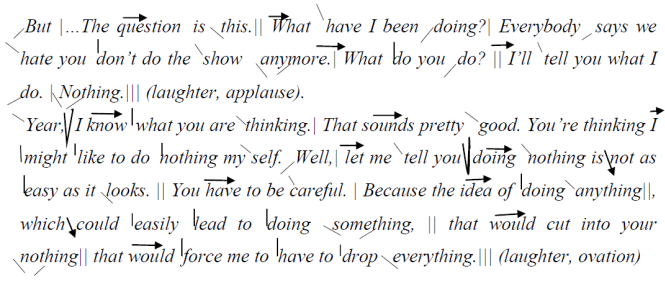
There are 96 words with 59 stressed syllables, 16 pauses. Tones: High Fall – 12, Low Fall – 3, Low Rise – 5, Fall-Rise – 4.
The impression of spontaneity pursues throughout the whole piece. Seinfeld interlaces his voice to attach special emphases to certain utterances. He uses both falling and rising tones to achieve emphases. However, the number of rising nucleus prevails in the first part of this excerpt, which is done deliberately. It shows surprise and perplexity, and even light-mindedness. The voice of the speaker conveys these emotions and the speaker himself remains quite serious which adds to the humorous effect he produces on the listeners.
Seinfeld varies his pitch a lot and uses pauses extensively. The pauses after
The pauses that signal the climax are also substantial. This indicates that the speaker is aware of focus to the point of manipulating it for humorous purposes. Seinfeld is hinting at emotion. As for the rate of his speech, it remains practically unchanged during the whole piece, though we can observe it slowing down a bit on the final punch line. From the above description, we can say that the focus phrases are prosodically marked. Together with very prominent falling nuclear tones, extended pitch range and pauses the speaker sounds very convincing and funny. He speaks impressively and naturally at the same time.
In every his performance Jerry Seinfeld makes the most of his intonation. His wish to entertain, surprise and convince the audience requires maximum of his vocal energy and he uses greater pitch variations and loudness. His behaviour on the stage and his voice are so interesting that people are prepared to listen to him and enjoy themselves.
Another native New Yorker stand-up comedian whom we focus on – Andrew Schulz. Being one of top young comics in the country he was 2018 and 2019 most viewed stand-up comedian on You Tube. He is a very energetic young man, who has the potential to be an amazing performer. His fervency on stage is obvious. His clear-cut voice is an advantage and helps him to command his audience. However, his humour is unapologetic, offensive, and constant profanity can diminish his performance. Andrew believes that this is a real comedy and it suits his crowd. Unlike Seinfeld he is not dressed in stylish suits, he is very casual in his outfit and conversational in performances.
The video taken for the analysis is an excerpt ‘Gender Inequality Isn’t All Bad’ (2018) from his show in one of NY comedy clubs. Andrew talks about the food served in different countries and attitude towards women in these countries and according to his viewpoint, these two things are inextricably linked to each other.
Now, jumping to perceptional analysis of his bits we can point out that the rate of his speech is about 155-165 syllables per minute, which is quite a normal rate for a public talk. Though he is performing in front of a small audience, where there is always a danger to speed up and speak fast Schulz is aware that the overall pace of delivery counts for most. In order not to be monotonous Andrew varies the tempo of the speech within his utterances. In the example below (figure
The speaker also considers the pause an important index of timing and embraces pauses in his monologue. It gives his listeners time to absorb his message. Longer pauses typically occur before and just after punch lines to let his listeners enjoy the joke.

There are 43 words with 23 stressed syllables, 9 pauses. Tones: High Fall – 3, Low Fall – 2, Low Rise – 4, Fall-Rise – 1.
From the onset of his performance, Schulz uses falling and rising tones as well as a fall-rise. His bits stimulate him to express his emotions and this results in a variation of pitch and loudness. In this except loudness increases on the words:
In the second group of informants there are two UK stand-up comedians.
Jack Whitehall, a young award-winning stand-up star, is an award-winning actor, comedian, presenter and writer.
Born in London in 1988 into a family of media types (an actress and a theatrical agent) Jack is considered to be a posh comedian with a posh accent. The actor started his career as a stand-up comedian at the Edinburgh Festival Fringe (2009), when he got his first nomination for 'Best Newcomer' at the Edinburgh Comedy Awards. The stand-up tours
The reason for choosing Jack Whitehall for the analysis is that he is a representative of young generation who comes from a privileged family, was educated in public schools and has an upper-class British accent. At the same time Jack who is pursuing his career in the USA is exposed to the influence of American English.
The videos taken for the study are extracts from his stand-up shows: Live at the Apollo (2018), Royal Variety Performance (2010). We think that the year, hence, level of his experience and different target audience in his shows will also affect the choice of prosodic features in his speech. Most of his shows are based on self-deprecation and the topic of national identity. Being a multifaceted actor and comedian Jack is very hyperactive and expressive in the shows, his mannerisms, mock accents and shouting are in his non-verbal repertoire.
The excerpt below (see figure
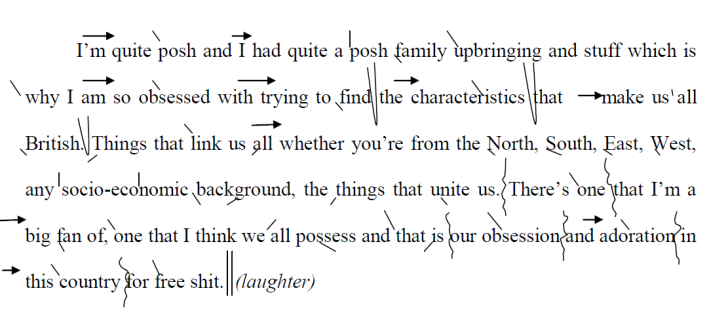
Tempo is fast throughout the extract, especially in the second sentence. He makes use of various lengths of pause: syntactical pauses, emphatic and a few extra short ones which mark the end of the syntagm. High pitch in contrast to mid is used to sound more emotional with a hint of self-mockery. The main tones which prevail are falling tones of different level (Low vs High), enumeration is pronounced in a fast tempo on a lower pitch level and loudness with falling tones. There are also a few Fall-Rising tones used as an introduction to the focus of the sentence (…
The episode lasts 22 seconds. There are 80 words with 44 stressed syllables, 9 pauses. Tones: High Fall – 11, Low Fall – 10, Rise – 2, Fall-Rise – 3.
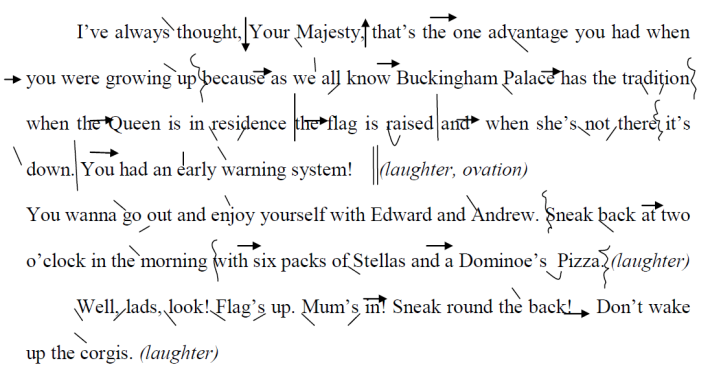
Jack performed at Royal Variety Performance at the London Palladium. The event was held in the presence of His Royal Highness the Prince of Wales and Her Royal Highness the Duchess of Cornwall. Being still a beginner in stand-up Jack was chosen to perform there after his successful debut in 2009.
We can clearly see the influence of extra linguistic factors (the role and status of the speaker and the guests) on Jack’s performance and prosodic features used (see figure
There are 93 words and 46 stressed syllables, 10 pauses in a 38-second episode. Tones: High Fall - 9, Low Fall – 8, Rise – 3, Fall-Rise – 6.
The second British comedian is Peter Kay. Born in 1973 in Bolton he became popular as a comedian in 1996 winning the North West Comedian of the Year. Peter Kay has received a number of prestigious awards among which is a BAFTA/LA Award (2009). The comedian still lives in Bolton. The reason for choosing Peter Kay as our informant is that he is a comedian who started his career at the end of the 20th century and has probably avoided much influence of the American style in his stand-up shows. Besides staying loyal to his local dialect (speaks Bolton accent (Lancashire)) may prove the fact of preserving his national identity in his performances.
The two extracts below are from Peter Kay’s stand-up Live at the Bolton Albert Halls (2003).
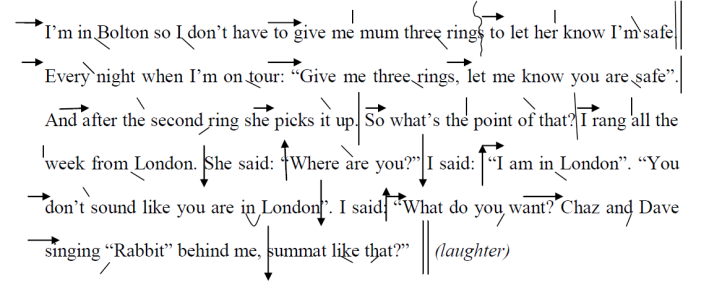
Moderate tempo changes into fast in the reporting clauses before direct speech and a comment (see figure
There are 93 words and 43 stressed syllables, 11 pauses in the episode lasting 56 seconds. Tones: High Fall - 7, Low Fall – 8, Rise – 4, Fall-Rise – 2.
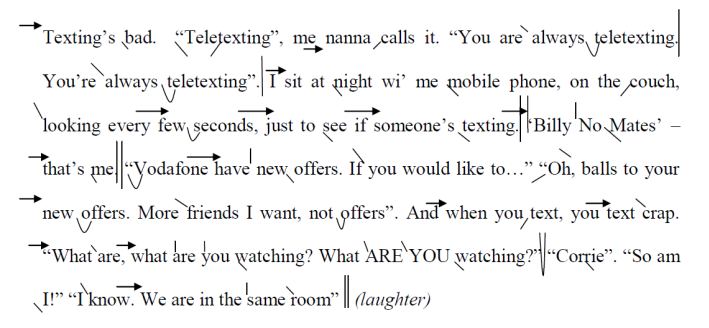
Just like in example 5 (mocking his mum’s speech) Peter Kay uses paralinguistic features – dialect switching – to achieve the effect of authenticity (switching from dialectal speech to normative to imitate an accent of a Vodafone representative) (see figure
There are 90 words and 62 stressed syllables, 5 pauses in the episode lasting 39 seconds. Tones: High Fall – 12, Low Fall – 12, Rise – 4, Fall-Rise – 7.
Russian stand-up comedy is a new genre for our country, which has become a significant part of our pop culture for the last 20 years. One of the most successful representatives of it is a 40-year old Ruslan Belyj who has been on stage since the mid-2000. His talks may cause discomfort as the comic uses a lot of profanities and rude words.
The extract is taken from his show in St. Petersburg (2019) where he was speaking about citizenship and tolerance (figure

There are 37 words with 29 stressed syllable, 5 pauses. Tones: Low Fall – 4, High Fall – 1, Low Rise – 11, Fall-Rise – 1.
Already in this passage, we can see rhetorical questions posed to the audience. To establish rapport with his listeners, to interact with them as well as to make the conversation sound more intimate comedians use this technique. This approach gives the audience the feeling of having a dialogue with them now while at the same time the comic performs a rehearsed monologue.
The tempo of his speech is quite fast. He makes very little pauses and they are short. The longest one is after the punch line. His pitch range is narrow. The style of speaking is conversational. Belyj uses a lot of rising tones even in the end of affirmative sentences which resembles an uptalk.
Another Russian stand up comedian is Pavel Volya (born in 1979) who is considered one of the first to introduce this type of entertainment genre in Russia in 2005. He tours with big stand-up shows, acts, performs and works on TV.
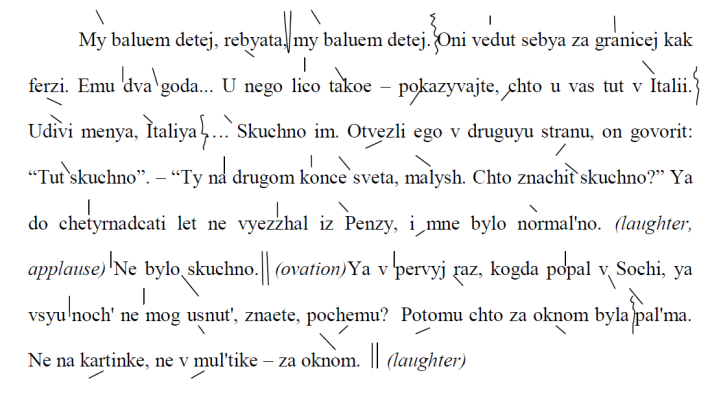
The excerpt is taken from his show (2019) where Pavel describes kids going on holiday (figure
Describing the manner of his presentation we notice simple sentences, a lot of repetition of the words which are meant to sound funny, drawling of sounds which is used for emphasis but also to imitate the way bored people speak. Rhythm is typically Russian – syllable-timed, tempo is moderate. Medium pitch is used with rising and falling tones, loudness is high. Highlighting is made on key words. We can notice rising tones used as pre-nuclear in the onset which demonstrates standard Russian intonation construction.
There are 96 words and 45 stressed syllables, 6 pauses in the episode lasting 38 seconds. Tones: High Fall - 16, Low Fall – 7, Rise – 9.
Conclusion
The style of the stand-up genre determines both non-verbal and speech behavior of a comedian.
The stand-up humour is deep and multifaceted but a joke is immediately apparent and the audience is eager to experience humour and ready to laugh. All comedians are highly motivated and interested in their talks; they speak their own, unique opinion and the audience does not mind the actors being offensive. The comedians are hyperactive on stage, they physically emphasize the funny moments in their talks, are verbally involved in the performance by using extra-, paralinguistic as well as prosodic features. They demonstrate the mastery of the form of stand-up. All four linguistic levels of stand-up realization were noticed.
All informants control their voice sounding natural: vary the pitch, exaggerate the contrasts in nuclei and loudness, tempo and pauses. On the whole the number of the prosodic parameters used by all nationalities was approximately the same, only Russian speakers had typically more Rising tones and no complex Fall-Rising. Sociophonetic aspect did not significantly influence the manner of presentation.
By and large, on the one hand, the speakers stick to their style of performance and their native manner of pronunciation, on the other, their stand-up is preserved in the international manner of the genre. So, if a comedian performs in the style of a stand-up, it will sound American because they adopt the stylistic features of American stand-up whether or not the comedian actually has or has not those features.
Thus, we can speak about unification concerning the style, genre and some speech patterns regardless of the actor’s geographical, social and cultural origin.
References
- Attardo, S., Pickering, L., & Baker, A. A. (2011). Prosodic and multimodal makers of humor in conversation. Pragmatics and Cognition, 19(2), 224-247.
- Blokh, M. Y., & Velikaya, E. V. (Ed.) (2012). Prosodiya v stilizacii teksta [Prosody in text stylistics]. Izdatel'stvo “Prometej”.
- Belyj, R. (2019). Pro grazhdanskuyu poziciyu i tolerantnost` [About citizenship and tolerance]. https://www.youtube.com/watch?v=Ajuueds55rk&t=276s
- Boldyrev, N. N., & Dubrovskaya, O. G. (2015). O formirovanii sociokul`turnoj specifiki diskursa [On the problem of sociocultural discourse specificity construction]. Voprosy kognitivnoy linguistiki, 3(044), 14-25.
- Brodie, I. (2008). Stand-up comedy as a genre of intimacy. https://www.researchgate.net/publication /273035632_Stand-up_Comedy_as_a_Genre_of_Intimacy
- Crystal, D. (2016). The gift of the gab: how eloquence work. Yale University press.
- Daube, M. (2009). Laughter in revolt: race, ethnicity, and identity in the construction of stand-up comedy. https://www.academia.edu/331773/Laughter_In_Revolt_Race_Ethnicity_and_Identity_In_the_Construction_of_Stand-Up_Comedy
- Gadzhiev, K. S. (2011). Nacional`naya identichnost`: konceptual`ny`j aspekt [National identity: conceptual aspect]. Voprosy filosofii, 10, 3-11.
- Gural, S. K., & Smokotin, V. M. (2014). Yazy`k vsemirnogo obshheniya i yazy`kovaya i kul`turnaya globalizaciya [Language of Global communication and language and cultural globalization]. Yazyk I kultura, 1(25), 4-13.
- Efimenko, T. N. (2009). Rol` inoyazy`chnoj leksiki v ob``ektivizacii vzaimodejstviya kartin mira [Contribution of foreign words in objectivation of worldviews interaction (dissertation of a candidate of pedagogical sciences)] [Doctoral Dissertation]. Institut yazykoznaniya RAN.
- Ivanova, Y. E. (2018). Prosodicheskoe oformlenie rechi amerikanskix i rossijskix televedushhix tok-shou [Prosodic features of the host’s speech: American and Russian TV talk shows]. Aktual`ny`e voprosy` lingvistiki i lingvodidaktiki: tradicii i innovacii. Proceedings of the international scientific and practical conference dedicated to the seventieth anniversary of the Institute of Foreign Languages, 123-129.
- Karasik, V. I. (2016). Diskursivnoe proyavlenie lichnosti [Discourse manifestation of personality]. Russian Journal of Linguistics, 20(4), 56-77.
- Kay, P. (2003). Peter Kay Live at the Bolton Albert Halls Universal Studios (UK) Ltd.
- Kudryavtsev, A. G. (2010). Vy`razhenie nacional`noj identichnosti v politicheskom diskurse: funkcii i mexanizmy` vozdejstviya na recipienta soobshheniya [Expression of national identity in political discourse: functions and mechanisms of producing influence of the recipient of the message]. Politicheskaya linguistika, 4(34), 115-117.
- Manzheleevskaya, E. V. (2017). Pragmaticheskie osobennosti rechi komikov, vy`stupayushhix v zhanre «ste`ndap» (na materiale anglijskogo yazy`ka) [Pragmatic peculiarities of the speech of comic actors performing in the genre “stand-up” (by the material of the English language)]. Filologicheskie nauki. Voprosy teorii I praktiki, 10(76), 107-111.
- Manwell, C. F. (2008). Stand-up comedy as a tool for social glance (B.A.’s thesis). https://lsa.umich.edu/content/dam/english-assets/migrated/honors_files/Manwell%20Colleen-Stand-Up%20Comedy%20as%20a%20Tool%20For%20Social%20Change.pdf
- Mikhaleva, E. I. (2018). Foneticheskie osobennosti britanskogo anglijskogo v e`poxu globalizacii [Phonetic peculiarities of British English in Globalisation era]. Aktual`ny`e voprosy` lingvistiki i lingvodidaktiki: tradicii i innovacii. Proceedings of the international scientific and practical conference dedicated to the seventieth anniversary of the Institute of Foreign Languages (pp. 142-148).
- Panchenko, S. A. (2017). Ste`ndap kak novy`j zhanr razvlekatel`nogo diskursa [Stand up as a new genre entertaining discourse]. Vistnik Dnipropetrovskogo universiteta. Movoznavstvo, 11, 23(1), 119-125.
- Rassoha, M. N. (2016). Metayazy`kovaya kommunikaciya v anglofonny`x kul`turax [Metalanguage Communication in Anglophone Culture]. Nauchnyj dialog, 11(59), 88-99.
- Scott, P. (1998). The Globalisation of Higher Education (The Society for Research into Higher Education). Buckingham: Open University Press.
- Schulz, A. (2018). Gender inequality is not all bad. https://www.youtube.com/watch?v=bHnfbGyoa6o
- Seinfeld, J. (2013). Stand-up comedy 2004-2013. Compilation. https://www.youtube.com/watch?v=R616u50ZFdY
- Shevchenko, T. I. (2016). Sociofonetika: nacional`naya i social`naya identichnost` v anglijskom proiznoshenii [Sociophonetics: National and social identity in English pronunciation]. LENAND.
- Volya, P. (2019). Ob otdy`xe s det`mi [About holidays with children]. https://www.facebook.com/watch/?v=823719854677038
- Wells, J. C. (2018). English intonation. Introduction. Cambridge University Press
- Whitehall, J. (2018). Live at the Apollo. https://www.youtube.com/watch?v=PnZ0A4AHTUs
- Whitehall, J. (2010). Royal Variety Performance. https://www.youtube.com/watch?v=Wp7KBdducNo
- Zheltukhina, M. R., Vikulova, L. G., & Borbotko, L. A. (2016). Identity as an element of human and language universes: Axiological aspect. International Journal of environmental and science education, 11(17), 10413-10422.
- Zheltukhina, M. R., & Vikulova, L. G. (2017). Communicative theatre space in the linguistic and pragmatic paradygm. XLinguae Journal, 10(2), 85-100.
Copyright information

This work is licensed under a Creative Commons Attribution-NonCommercial-NoDerivatives 4.0 International License.
About this article
Publication Date
20 November 2020
Article Doi
eBook ISBN
978-1-80296-094-5
Publisher
European Publisher
Volume
95
Print ISBN (optional)
-
Edition Number
1st Edition
Pages
1-1241
Subjects
Sociolinguistics, discourse analysis, bilingualism, multilingualism
Cite this article as:
Ivanova, Y. E., Mikhaleva, E. I., & Efimenko, T. N. (2020). Internationalization Of Stand-Up Comedians’ Speech Behavior: Loss Of National Identity?. In Е. Tareva, & T. N. Bokova (Eds.), Dialogue of Cultures - Culture of Dialogue: from Conflicting to Understanding, vol 95. European Proceedings of Social and Behavioural Sciences (pp. 293-305). European Publisher. https://doi.org/10.15405/epsbs.2020.11.03.31

